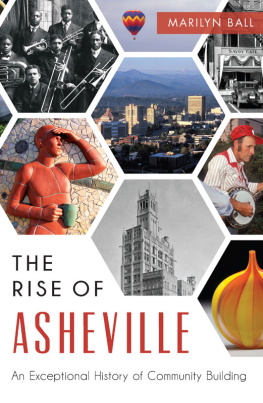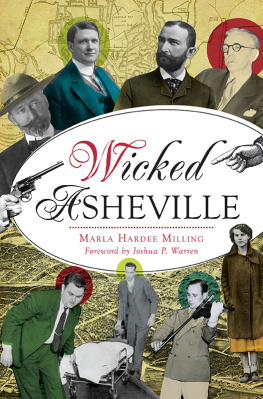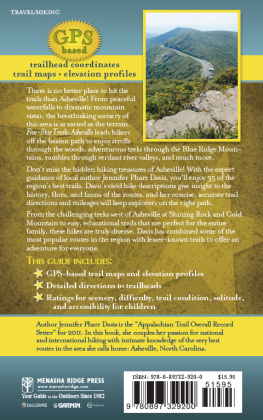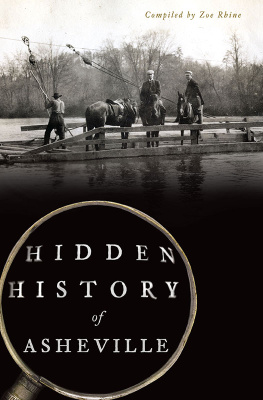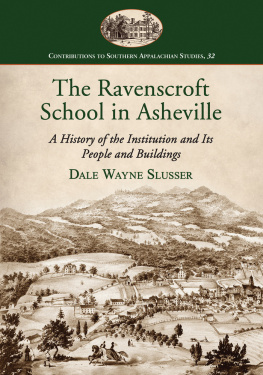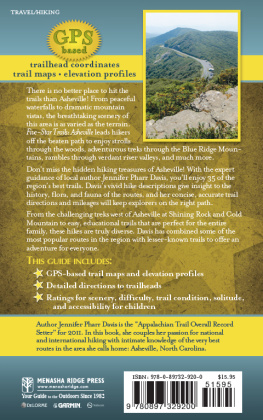

Published by The History Press
Charleston, SC 29403
www.historypress.net
Copyright 2015 by Marilyn Ball
All rights reserved
Front cover, clockwise from top left: The YMI orchestra, 1908. Courtesy of (p77.10.3.8.1a) Black Highlanders Collection, circa 18881972, D.H. Ramsey Library, Special Collections, University of North Carolina at Asheville 28804; Hot air balloon. Photo by Time Barnwell; Savoy Caf. Courtesy of (N1264) E.M. Ball Photographic Collection (19181969), D.H. Ramsey Library, Special Collections, University of North Carolina at Asheville 28804; Banjo player. Photo by Tim Barnwell; A glass vase. Photo by Tim Barnwell; Jackson Building, circa 1920s. Courtesy of (N1232) E.M. Ball Photographic Collection (19181969), D.H. Ramsey Library, Special Collections, University of North Carolina at Asheville 28804; Mural detail. Courtesy of Kathy Triplett; Downtown Asheville. Photo by Tim Barnwell.
First published 2015
e-book edition 2015
ISBN: 978.1.62585.546.6
Library of Congress Control Number: 2015941627
print edition ISBN 978.1.46711.757.9
Notice: The information in this book is true and complete to the best of our knowledge. It is offered without guarantee on the part of the author or The History Press. The author and
The History Press disclaim all liability in connection with the use of this book.
All rights reserved. No part of this book may be reproduced or transmitted in any form whatsoever without prior written permission from the publisher except in the case of brief quotations embodied in critical articles and reviews.
CONTENTS
DEDICATION

Bob Kelso. Courtesy of Marcia Kelso.
In 2013, Western North Carolina lost a quiet leader with the passing of Bob Kelso, founder of Kelso Advertising & Design, an iconic Ashevillebased ad agency serving this region for thirty-plus years.
Kelso loved the Western North Carolina mountains. Moving here in the late 1960s, he chose Asheville as his homea place where he could be himself, do what he loved to do and serve his community.
I first went to work for Kelso in 1991, a time when the state map of North Carolina literally ended in Asheville, while the far western counties appeared as a vast wilderness with few roads or towns. For the next eighteen years, we worked together as partners. He was a mentor and a teacher.
His love of this region and his gift for design attracted him to the emerging tourism industry desperately in need of economic help to survive. There was not yet a room tax for hotels, so most rural counties had little or no money for exposure to the outside world, but Kelso believed Western North Carolina had the potential to be a major travel destination and could create a sustainable economy around the tourism industry.
A small group of visionaries and community leaders recognized a kindred spirit and asked Kelso to assist in leveraging the little money they had to invest in a marketing program. Understanding the power of collaboration to achieve a bigger goal, he helped reshape the areas tourism industry over the next eighteen years.

Kelso offices from 1989 to 2009, Lexington and Walnut Streets, circa 197677. Courtesy of (aap023) Asheville Area Photographic Collection, Southern Highlands Research Center & D.H. Ramsey Library, Special Collections, University of North Carolina at Asheville 28804.
Kelso earned the respect of his peers, but what mattered most to him was the continued growth and success of his clients. His business model included acting with professional integrity, providing consistent results by partnering with his clients to understand their needs and developing costeffective marketing solutions, regardless of budget.
His clients showed their appreciation for the personal attention and the quality of work they received by renewing contracts year after year. He had many clients for over twenty years, a statistic mostly unheard of for an ad agency.
Kelso understood the importance of creating partnerships by collaboration and cooperation, and he encouraged his clients to foster a model for working together versus competing with one another. Always open-minded, he was willing to try new ideas and listen rather than dictate. In this spirit, he helped the region slowly begin to emerge as the travel destination it is today.
He lived by the same values that brought so many of us here. He was a colleague, friend and mentorand is the inspiration for this book.
FOREWORD
Since the first European settlers made their way into the southern Appalachian Mountains in the eighteenth century, Western North Carolina has been a land apart. Until the railroad was finished from Old Fort to Swannanoa after the Civil War, Asheville and the surrounding coves and valleys remained one of the most isolated regions in the eastern United States.
From that day to this, Western North Carolina has remained a place of great physical beauty combined with little commerce and less wealth. In 1904, when Horace Kephart was searching desperately for a blank spot on the map to retreat to during his famous midlife crisis, a place back of beyond, he chose the high mountains west of Asheville because there were so few people there. Imagine a place, then, that has remained relatively isolated, a place that tourists love to visit because of its breathtaking beauty but a place where very few choose to remain because of its poverty. Only recently has Ashevillethe small city in the center of the regionbecome a mecca for retirees and artisans, most of whom stay put, at least for three seasons of the year.
One of the results of Western North Carolinas long isolation is there exists a peculiar insider versus outsider view of the region and its people. For those whose ancestors have lived and mostly farmed in the mountains for generationsmyself includedthere is a fierce pride in who and what we are, a stubborn independence that can often get in the way of an evolving community. For those who come here seeking inspiration or peace in the southern mountains, there can be an equally determined impulse to improve the lot of the poor mountain folks, an impulse that can sometimes create more resentment than collaboration.
The wonderful thing about the stories Marilyn Ball tells in this book is they are peopled by natives and newcomers who reach across cultural and financial divisions that might have otherwise doomed their efforts. Men and women like Wayne Caldwell and Becky Anderson, whose families have lived and worked in the mountains for many generations, join forces with those who came here out of a genuine love for this place and its people. What is more, these natives and newcomers worked together to create real economic development in a crushingly poor region, without compromising the cultural riches that make this place unique.
My father, along with his brother and sisters, was born and raised in an isolated mountain cove. They had a saying that resonates in each and every page of this book: some of us were lucky enough to be born here; some of us were smart enough to come here. In each of these ten stories, those who were born here join hands with those who came here to create miracles of communication and community. May those of us who follow sustain what they started.
Next page
